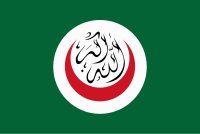
A crescent shape is a symbol or emblem used to represent the lunar phase in the first quarter, or by extension a symbol representing the Moon itself.

The national flag of Libya was originally introduced in 1951, following the creation of the Kingdom of Libya. It was designed by Omar Faiek Shennib and approved by King Idris Al Senussi who comprised the UN delegation representing the three regions of Cyrenaica, Fezzan, and Tripolitania at UN unification discussions.

The national flag of the Islamic Republic of Iran, also known as the tricolor, is a tricolor featuring the Pan-Iranian colors comprising equal horizontal bands of green, white and red with the national emblem ("Allah") in red centred on the white band and the takbir written 11 times each in the Kufic script in white, at the bottom of the green and the top of the red band. After the Iranian Revolution of 1979, the present-day flag was adopted on 29 July 1980.

The national flag of Algeria consists of two equal vertical bars, green and white, charged in the center with a red star and crescent, a symbol of Islam as the nation's prominent faith. The flag was adopted on 3 July 1962. A similar version was used by the Algerian government in exile from 1958 to 1962. The Western blazon is per pale vert and argent; a crescent and star gules.

The flag of Tunisia is a rectangular panel of red color with an aspect ratio of 2:3. In the center of the cloth in a white circle is placed a red crescent, surrounding a red five-pointed star on three sides. The Tunisian Bey Hussein II decided to create a flag for Tunisia, close in appearance to the modern one, after the Battle of Navarino on 20 October 1827; in 1831 he was officially approved. In that form, the flag existed during the French protectorate, and on 1 June 1959, it was proclaimed the state flag of the Republic of Tunisia. On 30 June 1999, the proportions and design of the flag were clarified by a special law. The general appearance of the flag remained virtually unchanged.
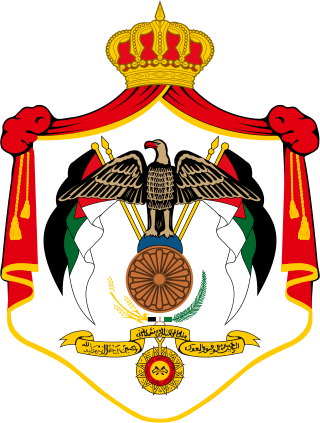
The coat of arms of Jordan or the emblem of the Hashemite Kingdom of Jordan is the arms of dominion for the king of Jordan. The emblem was initially adopted by Abdullah I, the emir of Transjordan, in 1921. The emblem continued to be used after Transjordan emerged as an independent kingdom in 1946.

The national flag of Egypt is a tricolour consisting of the three equal horizontal red, white, and black bands of the Egyptian revolutionary flag that dates back to the 1952 Egyptian Revolution. The flag bears Egypt's national emblem, the Egyptian eagle of Saladin, centred in the white band.

The flag of Turkmenistan features a white crescent and five stars representing the five regions of the country and the Five Pillars of Islam. Placed upon a green field is a symbolic representation of the country's famous carpet industry. It was introduced as the flag of Turkmenistan on 27 September 1992 to replace the Soviet-era flag which consisted of a red background with two light blue bars in the middle. The modified version with a 2:3 ratio was adopted on 23 January 2001. State Flag and Constitution Day is celebrated on 18 May.

The flag of the United Arab Emirates contains the Pan-Arab colors red, green, white, and black. It was designed in 1971 by Abdullah Mohammed Al Maainah, who was 19 years old at that time, and was adopted on 2 December 1971 after winning a nationwide flag design contest. The main theme of the flag's four colors is the sovereignty and unity of the Arab states.

The national flag of Uzbekistan consists of a horizontal triband of azure, white and green, separated by two thin red fimbriations, with a white crescent moon and twelve white stars at the canton. Adopted in 1991 to replace the flag of the Uzbek Soviet Socialist Republic (SSR), it has been the flag of the Republic of Uzbekistan since the country gained independence in that same year. The design of the present flag was partly inspired by the former one.
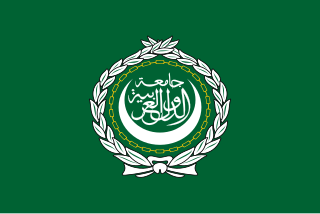
The flag of the Arab League comprises a green banner bearing the seal of the Arab League. The twenty-two links in the chain represent the twenty-two members of the League at the time of the flag's adoption. The script gives the name of the organization: "League of Arab States".

The star and crescent is a symbol which is a conjoined representation of a crescent and a star. It is used in various historical contexts, including as a prominent symbol of the Ottoman Empire, and in contemporary times used as a national symbol for some countries, and a recognized symbol of Islam. It was developed in the Greek colony of Byzantium ca. 300 BC, though it became more widely used as the royal emblem of Pontic king Mithridates VI Eupator after he incorporated Byzantium into his kingdom for a short period. During the 5th century, it was present in coins minted by the Persian Sassanian Empire; the symbol was represented in the coins minted across the empire throughout the Middle East for more than 400 years from the 3rd century until the fall of the Sassanians after the Muslim conquest of Persia in the 7th century. The conquering Muslim rulers kept the symbol in their coinage during the early years of the caliphate, as the coins were exact replicas of the Sassanian coins.
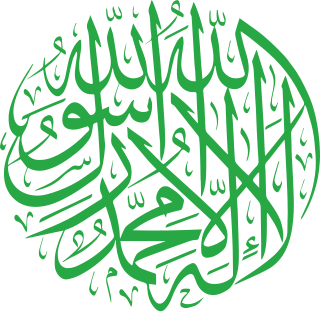
Islam is an Abrahamic monotheistic religion teaching that there is only one God (Allah) and that Muhammad is the last messenger of God. It is the world's second-largest religion, with over 1.9 billion followers, and Muslims form 24.4% of the world's population.

The State Emblem of Turkmenistan was created after Turkmenistan gained independence from the Soviet Union in 1991. Like other post-Soviet republics whose symbols do not predate the October Revolution, the current emblem retains some components of the Soviet one such as the cotton, wheat and rug. The eight-point green starburst with golden edges features in its center a red circular disc which carries sheaves of wheat, five carpet guls, and centered upon that a smaller blue circle with a lifelike depiction of former President Saparmurat Niyazov's pet Akhal-Teke horse Yanardag, a source of pride for the Turkmen people. A round variant of the emblem was used from 1992 until 2003, when President Saparmurat Niyazov proposed to change its appearance and said that the ancient Turkmen octagon has been considered to be a symbol of abundance, peace and tranquillity.

Since 2011, Libya currently does not have an official national emblem. The Constitutional Declaration issued by the National Transitional Council on August 2011 defines the flag of Libya, but does not make any provisions for a coat of arms.
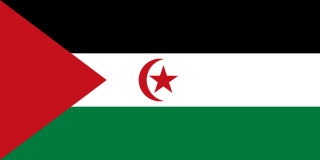
The flag of Western Sahara, also known as the flag of the Sahrawi Arab Democratic Republic, uses a national flag consisting of a black, white and green horizontal tricolor charged with a red star and crescent in the center stripe and a red chevron at the hoist. It is used on SADR-controlled areas, while the Moroccan flag is used on the occupied parts of Western Sahara.

An Islamic flag is the flag either representing an Islamic Caliphate or religious order, state, civil society, military force or other entity associated with Islam. Islamic flags have a distinct history due to the Islamic prescription on aniconism, making particular colours, inscriptions or symbols such as crescent-and-star popular choices. Since the time of the Islamic prophet Muhammad, flags with certain colours were associated with Islam according to the traditions. Since then, historical Caliphates, modern nation states, certain denominations as well as religious movements have adopted flags to symbolize their Islamic identity.
The flag of Earth is a concept of a possible flag design meant to symbolize the planet Earth, humankind, or a possible world government.
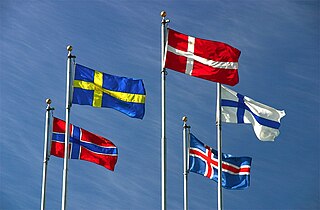
Flag families are sets of national flags with similarities in their design, often based on a shared history, culture, or influence. Families do not include flags with coincidental similarities. Flags may be in multiple flag families. Only twelve current national flags existed before the 19th century, when large-scale flag use began. Seven of these flags are the inspiration for more than 130 current national flags and ensigns.

